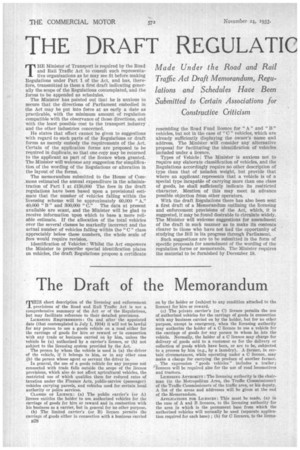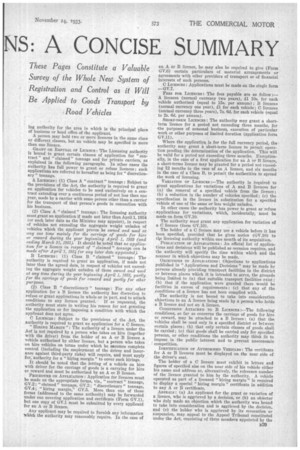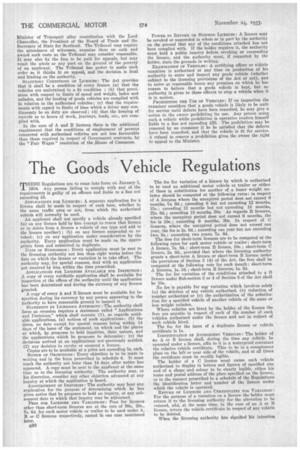THE DRAFT REGULATIC
Page 38

Page 39

Page 40

If you've noticed an error in this article please click here to report it so we can fix it.
NS: A CONCISE SUMMARY THE Minister of Transport is required by the Road and Rail Traffic Act to coiasult such representative organizations as he may see fit before making Regulations under Part 1 of the Act, and has, therefore, transmitted to them a first draft indicating generally the scope of the Regulations contemplated, and the forms to be appended as schedules.
The Minister has pointed out that he is anxious to secure that the directions of Parliament embodied in the Act may be put into force at as early a date as practicable, with the minimum amount of regulation compatible with the observance of those directions, and with the least possible cost to the transport industry and the other industries concerned.
He states that effect cannot be given to suggestions with regard to such parts of the Regulations or draft forms as merely embody the requirements of the Act. Certain of the application forms are proposed to be required in duplicate, so that one copy may be returned to the applicant as part of the licence when granted. The Minister will welcome any suggestion for simplification of the wording of the Regulations or alteration in the layout of the forms.
The memorandum submitted to the House of Commons estimated the annual expenditure in the administration of Part 1 at £130,000 The fees in the draft regulations have been based upon a provisional estimate that the number of vehicles falling within the licensing scheme will be approximately 60,000 "A," 40,000 " B " and 300,000 "C." The data at present available are scant, and the Minister will be glad to receive information noon which to base a more reliable estimate. If the allocation of the total vehicles over the several classes be markedly incorrect and the actual number of vehicles falling within the " C " class appreciably below these numbers, the whole scale of fees would require revision.
Identification of Vehicles : Whilst the Act empowers the Minister to prescribe special identification plates on vehicles, the draft Regulations propose a certificate
resembling the Road Fund licence for " A " and "B" vehicles, but not in the case of "C" vehicles, which are already sufficiently displaying the owner's name and address. The Minister will consider any alternative proposal for facilitating the identification of vehicles included under a licence.
Types of Vehicle : The Minister is anxious not to require any elaborate classification of vehicles, and the Regulations accordingly require no other description of type than that of unladen weight, but provide that where an applicant represents that a vehicle is of a Special type incapable of carrying more than one class of goods, he shall sufficiently indicate its restricted character. Mention of this may meet in advance possible objection from other operators.
With the draft Regulations there has also been sent a first draft of a Memorandum outlining the licensing and enforcement provisions of the Act, which, it is suggested, it may be found desirable to circulate widely. The Minister will welcome suggestions for amendment of the draft in such manner as to make its contents clearer to those who have not had the opportunity of studying the Bill in its progress through Parliament.
Such suggestionsare to he submitted in the form of specific proposals for amendment of the wording of the regulation forms or memoranda. The Minister requires the material to be furnished by December 18.
ing authority for the area in which is the principal place of business or head office of the applicant. A person may hold two or more licences in the same class or different classes, but no vehicle may be specified in more than one licence.
GRANT on REFVSAL or LICENCE: The Licensing authority is bound to grant certain classes of application for " contract " and " claimed " tonnage and for private carriers, as explained in the following paragraphs. In other cases the authority has full power to grant or refuse licences ; such applications are referred to hereafter as being for " discretionary" tonnage.
A. LICENCES : (1) Class A "contract" tonnage : Subject to the provisions of the Act, the authority is required to grant an application for vehicles to be used exclusively on a contract extending over a continuous period of not less than one year, made by a carrier with some person other than a carrier for the transport of that person's goods in connection with his business.
(2) Class A " claimed " tonnage: The licensing authority must grant an application if made not later than April 1,1934 (or such later date as the Minister may appoint), in respect of vehicles not exceeding the aggregate weight unladen of vehicles which the applicant proves he owned and used at any one time mainly for the carriage of goods for hire or reward during the year beginning April 1, 1932 (and ending March 31, 1933). It should be noted that no application for a licence in respect of "claimed" tonnage can be made after April 1, 1934 (or any later date appointed).
B LICENCES: (1) Class B " claimed " tonnage: The authority is required to grant an application, if made not later than the agreed date, in respect of vehicles not exceeding the aggregate weight unladen of those owned and used at any time during the year beginning April 1, 1932, partly for the carriage of goods for reward and partly for other pair poses.
(2) Class B " discretionary " tonnage : For any other application for a B licence the authority has discretion to refuse or grant applications in whole or in part, and to attach conditions to any licence granted. If so requested, the authority must state in writing his reason for not granting the application or for imposing a condition with which the applicant does not agree.
C Licneicns: Subject to the provisions of the Act, the authority is required to grant an application for a C licence.
" Hmixo MkaorrN " : The authority of a licence under the Act is not required by a person who takes on hire (together with the driver) from the bolder of an A or B licence a vehicle authorized by either licence, but a person who takes on hire vehicles on terms under which he assumes complete control (including the employment of the driver and insurance against third-party risks) will require, and must apply for, authority for a "hiring margin" to cover such hirings.
It should be noted that the letting of a vehicle on hire with driver for the carriage of goods is a carrying for hire or reward and must be authorized by an A or B licence.
PROCEDURE ON APPLICAT/ON : Application for licences must be made on the appropriate forms, viz., " contract " tonnage, GV.2 ; " claimed " tonnage, GV.3 ; " discretionary " tonnage, GV.4; "hiring margin," CV.5. More than one of these forms (addressed to the same authority) may be forwarded under one covering application and certificate (Form GV.1), but one copy of GV.1 must be submitted by every applicant for an A or B licence.
Any applicant may be required to furnish any information which the authority may reasonably require. In the case of an A or B licence, he may also be required to give (Form GV.6) certain particulars of material arrangements or agreements with other providers of transport or of financial interests of such persons.
C LICENCES: Applications must be made on the single form —GV.7.
FEES FOR LIC:ENCES : The fees payable are as follow :— A licences (normal currency two years), £1 10s. for each vehicle authorized (equal to 15s. per annum) ; B licences
(normal currency one year), for each vehicle; C licences (normal currency three years), 7s. 6d. for each vehicle (equal to 2s. 43(1. per annum).
SHORT-TERM LICENMS : The authority may grant a shortterm licence for a period not exceeding three months, for the purposes of seasonal business execution of particular work or other purposes of limited duration (application form GV.11).
Where the application is for the full currency period, the authority may grant it short-term licence to permit operation pending the determination of the application. This will be valid for a period not exceeding three months. Exceptionally, in the case of a first application for an A or B licence, a short-terms licence may be granted for a period not exceeding 12 mouths in the case of an A licence, and six months in the ease of a Class B, to permit the authorities to spread the work of licensing.
VARIATION OF LICENCES :—The authority is required to grant applications for variations of A and B licences for
(a) the removal of a specified vehicle from the licence; (b) a reduction in the number of vehicles specified ; (c) the specification in the licence in substitution for a specified vehicle of one of the same or less weight unladen.
In other cases the authority has power to grant or refuse applications for variations, which, incidentally, must be made on form GV.10.
The authority must grant any application for variation of C licence (form (IV.10).
The holder of a C licence may use a vehicle before it has been specified, provided that he gives notice (GV.10) to the licensing authority within one month of its acquisition.
PustacAnow or APPLECATIONS : An official list of applications and decisions will be published as occasion requires, and the authority will specify the time within which and the manner in which objections may be made. OBJECTIONS TO APPLICATIONS: Objections to applications published in "Applications and Decisions" may be made by persons already providing transport facilities in the district or between places which it is intended to serve, the grounds being limited to (a) that suitable transport facilities exist ; (b) that if the application were granted there would be facilities in excess of requirements : (c) that any of the conditions of a licence has not been complied with.
The authority is not bound to take into consideration objections to an A licence being made by a person who holds a B licence and not an A licence.
CONDITIONS ATTACHED TO B LICENCCS :—The following conditions, so far as concerns the carriage of goods for hire or reward, may be attached to a B licence: (a) that the vehicles shall be used only in a specified district or between certain places; (b) that only certain classes of goods shall be carried ; (e) that goods shall be carried only for specified persons, or other conditions the authority may think fit to impose in the public interest and to prevent uneconomic competition.
IDENTIFICATION OF AUTHORIZED VEHICLES : The certificate for A or B licences must be displayed on the near side of the driver's seat.
The holder of a C licence must exhibit in letters and figures of specified size on the near side of his vehicle either his name and address or, alternatively, the reference number of the licence granted to him by the authority. A vehicle operated as part of a licensed "hiring margin" is required to display a special "hiring margin" certificate in addition to any A or B certificate.
APPEALS: (a) An applicant for the grant or variation of a licence, who is aggrieved by a decision, or (b) an objector who duly made an objection which the authority was bound to take into consideration and is aggrieved by the decision, and (c) the holder who is aggrieved by its revocation or suspension, may appeal to the Appeal Tribunal constituted under the Act, consisting of three members appointed by the Minister of Transport after consultation with the Lord Chancellor, the President of the Board of Trade and the Secretary of State for Scotland. The Tribunal may require the attendance of witnesses, examine them on oath and award such costs as the Tribunal may consider reasonable. It may also fix the fees to be paid for appeals, but may remit the whole or any part on the ground of the poverty of an applicant. The Tribunal has power to make such order as it thinks fit on appeal, and the decision is final and binding on the authority.
STATerroav Cotenrriows or L/CENCES : The Act provides that it shall be a condition of every licence (a) that the vehicles are maintained in a fit condition ; (b) that provisions with respect to limits of speed and weight, laden and unladen, and the loading of goods vehicles are complied with In relation to the authorized vehicles; (a) that the requirements with regard to limits of time which a driver may continuously be on duty are observed ; (d) that the keeping of records as to hours of work, journeys, loads, etc., are complied with.
• In the case of A and B licences there is the additional requirement that the conditions of employment of persons connected with authorized vehicles are not less favourable than those required in respect of Government contracts, by the "Fair Wages" resolution of the House of Commons.
POWER TO REVOKE OR SUSPEND LICENCES: A licence may be revoked or suspended in whole or in part by the authority on the ground that any of the conditions attached has not been complied with. If the holder requires it, the authority must hold a public inquiry before revoking or suspending the licence, and the authority must, if requested by the holder, state the grounds in writing.
EXAMINATION OF VEHICLES: A certifying officer or vehicle examiner is authorized at any time on production of his . authority to enter and inspect any goods vehicle (whether subject to the licensing provisions of the Act or not), and to enter at reasonable hours any premises on which he has reason to believe that a goods vehicle is kept, but no authority is given to those officers to stop a vehicle when it is in motion.
Paonasinao THE USE OF VEHICLES: If on inspection the examiner considers that a goods vehicle is likely to be unfit for service until defects have been 'remedied, he may give a notice to the owner prohibiting its use. Any person using such a vehicle while prohibition is operative renders himself liable to a fine not exceeding £20. The prohibition may be removed by an examiner if he be satisfied that the defects have been remedied, and that the vehicle is fit for service. A refusal to remove a prohibition gives the owner the right to appeal to the Minister.




















































































